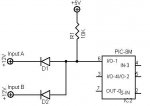I have two input circuits. Both are sitting at +12v and I want to know when one of them goes to 0v (ground).
This is just the basic to show the question and the Picaxe is not finished, etc.
When either line goes to ground the input to the Picaxe should go low.
My question is with the 5V on the back of the diode and 12v on the other side do I still have adequate protection for the Picaxe or do I need to add something .... other than an opto.
Thanks for the help.
This is just the basic to show the question and the Picaxe is not finished, etc.
When either line goes to ground the input to the Picaxe should go low.
My question is with the 5V on the back of the diode and 12v on the other side do I still have adequate protection for the Picaxe or do I need to add something .... other than an opto.
Thanks for the help.
Attachments
-
9.3 KB Views: 94
-
2 KB Views: 33
Last edited:




